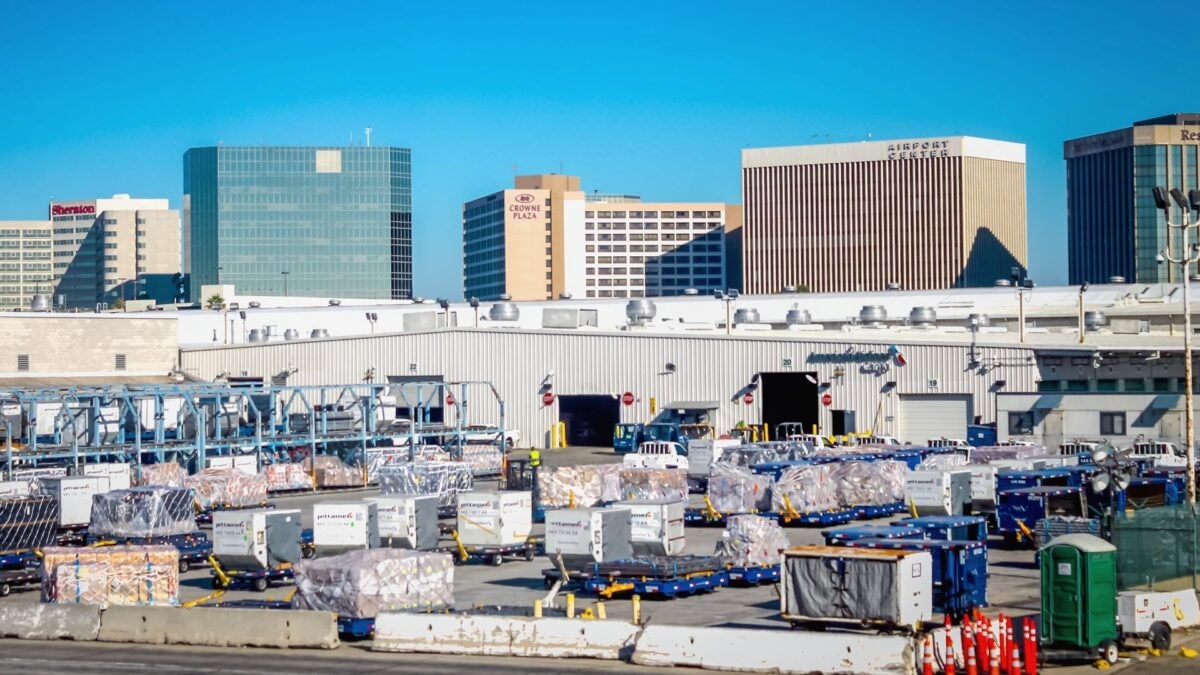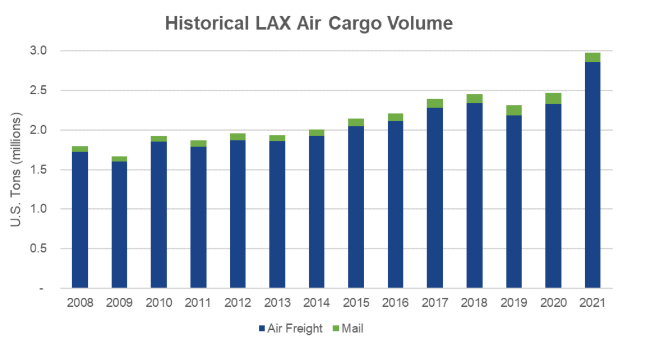A long-stalled redevelopment of crowded and obsolete cargo warehouses at Los Angeles International Airport is finally underway after city officials recently requested proposals for the wholesale redevelopment of 27 cargo buildings.
The solicitation in September only covers the first phase of modernization but implies that most of the existing cargo real estate at the airport will be replaced.
The cargo improvement project is the most ambitious of its kind ever attempted in the U.S., considering the potential scope of rehabilitation and the fact that Los Angeles is the nation’s largest traditional international gateway. It handled 3 million tons of cargo in 2021 — more than double the amount moved through John F. Kennedy International Airport in New York.
Los Angeles World Airports (LAWA), the agency that runs LAX, postponed the cargo overhaul three years ago because it had its hands full managing the start of an $18 billion project that includes modernizing passenger terminals, upgrading access roads and building an elevated people mover train. The COVID crisis pushed back the effort by another year or more.
Experts say LAX needs a major cargo upgrade to remain competitive and grow. The newest facilities opened 20 years ago.
“Many of the current cargo facilities are not compatible with current industry operating standards,” and road and airside impediments may inhibit improvements, the request for proposal said.
Officials seek a qualified developer that will design, build, finance, operate and maintain a modern cargo complex in exchange for fixed annual rent on the land and some form of profit sharing. Before the pandemic, LAWA entertained the idea of tearing down far-flung facilities and replacing them with a two-story cargo center. The new RFP instead gives latitude to developers to offer innovative approaches for how the cargo area should function.
“It’s all about looking at the asset and optimizing the design to build not only air cargo capabilities for next year or the next five years but for three or four decades to come,” said Nick Vyas, executive director of the University of Southern California’s Kendrick Global Supply Chain Institute.
Based on previous assessments and the complexity of large infrastructure projects it will be at least three years before environmental assessments are completed and any dirt is turned. Officials say they will work with the selected developer to identify a delivery schedule for each phase.
Freight forwarders, airlines, ground handling agents and shippers have grown increasingly frustrated over the past decade by crowding and delays that often force delivery drivers to wait several hours for loads.
Los Angeles International Airport is the fourth largest U.S. airport by tonnage, according to Airports Council International-North America. The only airports that handle more cargo are not comparable: FedEx and UPS dominate traffic at their hubs in Memphis, Tennessee, and Louisville, Kentucky, respectively, and Ted Stevens Anchorage International Airport in Alaska is where airlines on trans-Pacific routes make technical stops to refuel and change crews, more than transfer cargo.
In contrast to integrated logistics hubs such as FedEx and UPS, gateways like LAX, JFK and Chicago O’Hare International Airport host cargo operations for dozens of international all-cargo and passenger airlines with belly cargo that lack the volume to justify their own facilities and depend upon multi-tenant facilities and third-party cargo handling.
Los Angeles airport’s cargo facilities are concentrated in three areas totaling 2.6 million square feet of building space and 3.5 million square feet of ramps for aircraft, including 37 widebody parking positions. Increased exports and imports of perishable food products and pharmaceuticals have increased the need for specialized facilities such as cold storage and fumigation. Many ground leases expire within the next five years.
About 23 all-cargo airlines operate at LAX.

Skylark Consulting Group last year forecast air cargo in the Los Angeles region, including Ontario International Airport, will increase at a 2.6% compound annual growth rate to 7.7 million tons in 2045.
Airports make cargo investments
Major U.S. airports in recent decades have focused on improving passenger terminals, while underinvesting on the cargo side, according to logistics professionals and aviation analysts. Many terminals don’t have adequate room to efficiently deconsolidate and stage cargo for pickup because they are narrow and low, have limited truck access and dock doors and haven’t adopted appointment systems.
Antiquated infrastructure is partly to blame for extreme periods of cargo congestion that occurred at many major airports during the pandemic, when demand for medical equipment and e-commerce shipments skyrocketed and freighter activity multiplied because most passenger service shut down. Poor service has motivated many logistics companies and all-cargo carriers to relocate some business to secondary airports that are able to prioritize cargo and expedite inbound and outbound transfers.
“When you look at the existing facilities that were circa 1950s, 1970s, 1980s, there is a need for state-of-the-art, highly functional air cargo facilities [at these gateways],” said Kent Hindes, a Los Angeles-based senior director for commercial real estate services firm Cushman & Wakefield.
Gateways have an advantage over niche airports in greater network connectivity from a range of airlines offering diverse capabilities, international routes and frequencies.
Airport authorities are beginning to turn more attention to cargo, realizing that a true gateway needs a strong mix of passenger and cargo traffic to attract customers interested in a choice of global connections.
Miami International Airport and Chicago O’Hare have completed incremental cargo improvements over the past 20 years and don’t need a massive overhaul. Aeroterm delivered the first two sections of a new multi-user cargo complex at O’Hare in 2016, with the third phase expansion nearing completion. FedEx Express and DHL Express last year completed large expansions of their private facilities at Miami.
The Port Authority of New York and New Jersey in 2021 initiated a concession process to redevelop JFK’s cargo facilities but never issued a request for proposals. The agency signed an agreement with developer Aeroterm to build a modern 348,000-square-foot cargo processing center at an estimated cost of $145 million. It is the first new cargo building at JFK in two decades but is limited to the one site and sits on land already controlled by Aeroterm.
Atlanta’s Hartsfield-Jackson International Airport recently completed a cargo improvement project and Dallas-Fort Worth International Airport has added new facilities in recent years. Down a level, Philadelphia International Airport is pursuing a major expansion with the intent of becoming a significant East Coast cargo hub, and Pittsburgh International Airport is investing in cargo expansion.
The LAX project is potentially unique because it likely will involve a comprehensive transformation whereas other airports have done localized cargo expansions.
LAX cargo priorities
Adding new cargo capacity at LAX is extra challenging because the airport is surrounded by existing neighborhoods and the Pacific Ocean and doesn’t have idle space where operations can be relocated while existing facilities are overhauled, according to infrastructure experts.

The RFP asks developers to consolidate cargo facilities to reduce total land devoted to those operations and co-locate belly cargo, freighter and express delivery activities where possible to improve efficiency. Officials say the layout of some facilities has created “dead zones” that don’t offer optimal use of valuable property.
Hindes agreed that LAWA needs to create a self-contained, interconnected cargo village that is not spread all over airport property, as it is now.
Other goals include configuring buildings to improve cargo flow around the airport, utilizing the latest processing technologies to improve throughput velocity and implementing a truck staging and metering system to reduce dwell times at docks and traffic congestion.
According to the RFP, the airport authority will select a short list of technically and commercially qualified companies to bid on the initial phase of the redevelopment. Transportation infrastructure experts say incumbents typically are retained for future phases if they successfully meet all established criteria in the early stages.
Cargo tonnage is down 3.9% year to date through August versus 2021 but is on track for the second-best year in the airport’s history.
(Correction: The cover photo has been changed to show the actual FedEx freight terminal at LAX. The previous picture showed the FedEx maintenance hanger.)
Click here for more FreightWaves/American Shipper stories by Eric Kulisch.
Subscribe to the American Shipper Air newsletter
WHAT TO READ NEXT:
Fed up with cargo congestion, freight forwarders flee O’Hare airport











